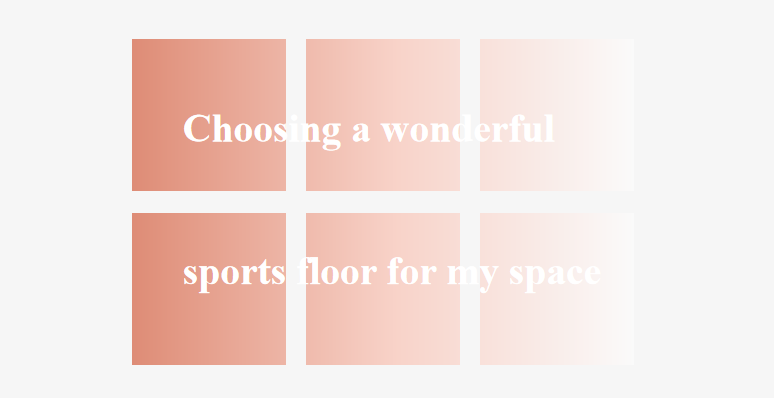The popularity of ball games continues to grow in the first half of 2023. Sports flooring very much affects athletic performance, and different sports flooring materials offer different benefits. The inappropriate or unsuitable flooring material can affect the user’s sporting performance. This is important in some professional competitions and may even affect the game’s outcome.
With advances in technology and raw materials, sports flooring materials are becoming more and more varied today. Different flooring materials have different prices and sporting performance. So their price range from a few dollars to hundreds of dollars per square meter. What exactly is the difference between these flooring materials?

Don’t be afraid, now Copocourt will help you explain and analyze the differences, the value, the popularity, and the quality!
1. Wooden Sports Flooring
Sports wood floors are used in the interiors of most modern sports stadiums. Professional ball games are also held on wooden flooring courts. The difference between sports wood flooring is mainly in the surface layer, according to the material can be divided into three categories.
Hardwood Sports Flooring
Common materials are maple, oak, and Quercus, the surface is made of natural wood.

Advantages: non-toxic and odorless, comfortable for movement, warm in winter and cool in summer.
Disadvantages: bad for the ecological environment, complex installation, stabilization layer must have a keel, high maintenance costs, the floor is greatly affected by temperature and humidity, easy to deform.
Engineered Wood Sports Flooring

It is made of interlocking laminates of panels from different tree species, with very low wood requirements and therefore low prices, little influence by climate, easy installation, low maintenance costs, and stable product quality. But it has high formaldehyde, not good for health. Also with poor abrasion resistance, non-repairable.
Laminate Wood Sports Flooring
(also called floating wood tile in America)

It is often found in home decor, the laminate floor has one or more layers of special paper impregnated with thermosetting amino resin, laid in particleboard, high-density fiberboard, and other man-made board substrate surface layer, the back plus a balanced moisture-proof layer, the front plus wear-resistant layer and decorative layer, hot pressing, molding of the floor. High surface hardness, pollution resistance, corrosion resistance, and easy maintenance.
It also has its disadvantages, such as poor athletic performance, bad patterns, and being very afraid to water and humidity.
BPC Sports Flooring
(The Biomass Plastic Composite sports flooring)

A new material that is environmentally friendly with recyclability. It is based on wood fiber, with bamboo fiber as the main raw material, and then with polymer chemical fusion, mixed with plastic base material, supplemented with compatibilizers, processed and molded by special technology. This new material overcomes all the disadvantages of hardwood flooring.
2. PVC Sports Flooring
PVC sports flooring is based on polyvinyl chloride and its copolymer resin as the main raw material, adding fillers, plasticizers, stabilizers, coloring agents, and other auxiliary materials, and then in the sheet-like continuous substrate, through the coating process or extrusion process manufactured.

Advantages: Environmentally friendly, ultra-light and ultra-thin, super wear-resistant, highly elastic and super impact-resistant, super non-slip.
Disadvantages: The ground should be completely horizontal only, PVC by high temperature is easy to deform, and the surface is easily broken.
3. Rubber Sports Flooring
It is natural rubber, synthetic rubber, and other components of polymer materials made of flooring.

Advantages: Environmentally friendly, non-slip, wear-resistant, high temperature resistant, good soundproofing, easy to install.
Disadvantages: The ground should be completely horizontal only, has poor colorability, very little color, is very afraid of water, and can only be cleaned with special cleaners.
4. PP Sports Flooring
PP(Polypropylene) flooring is made of polypropylene as the main material initially used in futsal courts and later used by other sports.

Advantages: Nice sports performance, eco-friendly, lots of floor colors, easy to install, low maintenance.
Disadvantages: The joints are easily damaged, and the floor is prone to buckling, shifting, and deformation after thermal expansion and contraction.
5. TPE Sports Flooring
It uses thermoplastic elastomer as raw material, processed into a new plastic flooring type.

Advantages: Acid and alkali resistance, corrosion resistance, no deformation, environmentally friendly recycling, can be 100% recycled, easy to pave, more color choices, better sports performance.
Disadvantages: higher price, small market share, not yet used in official competitions.
6. Material Recommend for your sports court
Here I’ve compiled a list of the most prevalent concerns when looking for sports flooring materials, which will hopefully help you build the best sports court!
| Lifetime | Performance | Maintenance | Price | Usage | |
| Hardwood | middle | professional | high | high | multi-sport |
| Engineered Wood | long | good | low | middle | basketball |
| Laminate wood | long | average | low | low | basketball |
| BPC | long | professional | zero | high | multi-sport |
| PVC | middle | good | middle | middle | badminton tennis |
| Rubber | middle | good | middle | high | gym |
| PP | short | average | low | low | multi-sport |
| TPE | long | professional | low | middle | multi-sport |
If you have any other questions about sports flooring materials, please leave a message and I’ll add the answer to the article, thank you!
发表回复